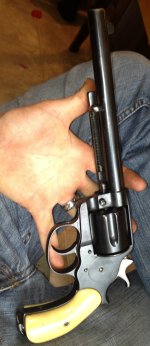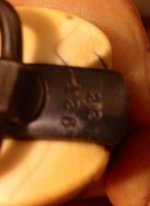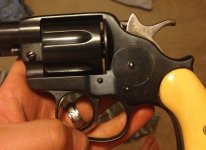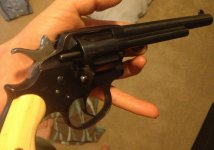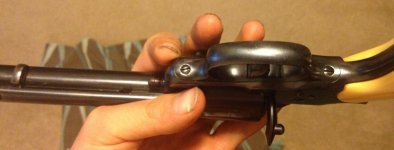Hi I just got a revolver no idea what it is or any thing other than it says colt on top and its a 38 I don't k ow if its a 38 special or not I'm unfamiliar with revolvers I usually just mess with 1911s so any help is greatly appreciated also the cylinder is really loose the guy who gave it to me said it was and is very clearly loose even when cocked it moves almost a 1/4 inch
You are using an out of date browser. It may not display this or other websites correctly.
You should upgrade or use an alternative browser.
You should upgrade or use an alternative browser.
Help
- Thread starter 72-cj5
- Start date
I'm no expert but looks like an 1878 Colt Double Action or Frontier.
You say .38 but most likely .38-40. Do chambers and muzzle look to be
about .40 caliber? Barrel marked .38 Win?
I don't see any markings, such as the rampant Colt stamping on lower part of frame near grips nor any markings on the barrel. I suspect it's been buffed down a lot and then reblued.
You say .38 but most likely .38-40. Do chambers and muzzle look to be
about .40 caliber? Barrel marked .38 Win?
I don't see any markings, such as the rampant Colt stamping on lower part of frame near grips nor any markings on the barrel. I suspect it's been buffed down a lot and then reblued.
Last edited:
No the only markings on the whole gun are on the very top of the barrel it says colts PT. F. A. MFG. co Hartford ct.u.s.a and on the left side just in front of the trigger it says 38 cal and on the very button if the grip it say 22 126 and then the last mark is on the little loader flip out cover it says 132
Hawg Hagen, thanks for jogging my memory: .38 WCF (for .38-40 Winchester Central Fire)
72-cj5, its lacking any etchings, markings, still makes me think that it was buffed down a lot and reblued to get rid of pitting and a host of other failings. You really need to take it to someone knowledgeable with the older guns to check it out.
I can make out the .38 marking in the front part of the trigger guard. But really try to measure the muzzle diameter to see if it's near 4/10ths of an inch or .40 caliber.
What is the serial number? You say the only marking is on the top of the barrel indicating its patent dates. Any numbers that match anywhere--the bottom of the butt, the bottom of the frame---anywhere?
Being from the black powder era I'd be reluctant to put any kind of modern ammunition into it.
72-cj5, its lacking any etchings, markings, still makes me think that it was buffed down a lot and reblued to get rid of pitting and a host of other failings. You really need to take it to someone knowledgeable with the older guns to check it out.
I can make out the .38 marking in the front part of the trigger guard. But really try to measure the muzzle diameter to see if it's near 4/10ths of an inch or .40 caliber.
What is the serial number? You say the only marking is on the top of the barrel indicating its patent dates. Any numbers that match anywhere--the bottom of the butt, the bottom of the frame---anywhere?
Being from the black powder era I'd be reluctant to put any kind of modern ammunition into it.
Last edited:
OK, Serial # 22126 would place it in 1888.
Black powder means that was what propellent was being used and the proofing of the steel may preclude use of any modern produced ammo because of pressure curves.
You still haven't indicated the diameter of the muzzle hole, closer to 4/10ths of an inch or 3/10ths of an inch. Or in other words .40 or .36 in round numbers.
I beginning to wonder if you're a troll.
Black powder means that was what propellent was being used and the proofing of the steel may preclude use of any modern produced ammo because of pressure curves.
You still haven't indicated the diameter of the muzzle hole, closer to 4/10ths of an inch or 3/10ths of an inch. Or in other words .40 or .36 in round numbers.
I beginning to wonder if you're a troll.
Just so you understand black powder does not exclusively mean muzzle loader. In the early days brass cased cartridges were filled with black powder. They were the predecessor to the modern round that uses smokeless powder. The only cartridge still commonly in use today utilizing smokeless powder in a case designed for black powder is the 22LR. I'm sure if there are others the guys here will be able to point them out.
Looks like you scored a nice piece there and taking it to a competent gs and letting them look it over is your best course of action. They should be able to determine it's suitability for firing then educate you on the guns history and safe use.
Keep us posted.
Looks like you scored a nice piece there and taking it to a competent gs and letting them look it over is your best course of action. They should be able to determine it's suitability for firing then educate you on the guns history and safe use.
Keep us posted.
The .38 Special, .45 Colt, .44-40 were all black powder cartridges. I believe the .44 Special was the last centerfire cartridge specifically designed for black powder.
This is why those cases are all so long, relative to their normal factory load power. (Edit: the .357 Magnum, .44 Magnum etc were all designed in the smokeless era, but had to be designed with long cases so they could not be fit into guns that could not handle the pressure.)
On the rifle side, .30-30, .45/70, and I think the .32 Special were designed around black powder.
There are several others; definitely not just the .22LR.
This is why those cases are all so long, relative to their normal factory load power. (Edit: the .357 Magnum, .44 Magnum etc were all designed in the smokeless era, but had to be designed with long cases so they could not be fit into guns that could not handle the pressure.)
On the rifle side, .30-30, .45/70, and I think the .32 Special were designed around black powder.
There are several others; definitely not just the .22LR.
OEF-Vet, thanks; I have picked up a lot of very useful info via TFL over the years (especially with regard to how NOT to break federal law when conducting interstate transactions).
The crowd here tends to be pretty helpful.
Sorry if that last post seemed like a dig; it wasn't, I am just a bit blunt.
The crowd here tends to be pretty helpful.
Sorry if that last post seemed like a dig; it wasn't, I am just a bit blunt.
MLeak not at all. My knowledge of BP cartridges is limited at best and I truly appreciate the enlightenment. I knew about the .22LR because I happen to have an affinity for the round. I also knew there had to be other holdovers but my knowledge in the arena stops short. I meant it when I said you have inspired me to learn more about BP cartridges as others have done here at TFL on a myriad of gun related topics.
Just an FYI, in Cowboy Action Shooting under the Single Action Shooting Society a category exists for black powder shooters that not only include the sixguns and rifles but also the shotguns.
A friend of mine has consistently won SASS championships using black powder cartridges. On nearly windless days, it's funny to see the BP shooters duck and sidestep to get out of the way of their lingering smoke clouds so they can see the targets.
Another friend insists on using near full charges of black powder for his .44-40s and his 12 gauge shotgun. For the shotgun he uses brass casings. The range officer and target spotters are always in for a treat when he lets go, especially from a short barreled sixshooter as opposed to his 7.5 barreled one.
Another historical curiosity is that the .45 Colt started out using 40 grains of black powder but because of cylinder failures (the chamber walls were mighty thin in the Colts), the manufacturers backed off to around 38 or 37 grains. The .44-40 and .38-40 nominally carried 40 grains each because of slightly lighter bullets and more steel around the cartridges because of their smaller size compared to the .45 Colt. A .45 Colt usually had a 250 grain bullet in .455 caliber whereas the .44-40 though nearly as heavy had a .426 or .427 caliber bullet and of course the .38-40 was really a .40 caliber. And yes, the official names were .44 WCF and .38 WCF standing for Winchester Central Fire and originally designed for the Winchester '73.
Just a safety precaution regarding "sixshooters" of the 19the Century and current production Colt SAAs and their clones, load only five rounds and keep the hammer down on an empty chamber. Although a quarter cock "safety" does exist, it's marginal and prone to breakage and today's primers are much, much, much more sensitives compared to the ones in the 19th Century. This rule also applies to the "three screw" Ruger Blackhawks and .22s.
A friend of mine has consistently won SASS championships using black powder cartridges. On nearly windless days, it's funny to see the BP shooters duck and sidestep to get out of the way of their lingering smoke clouds so they can see the targets.
Another friend insists on using near full charges of black powder for his .44-40s and his 12 gauge shotgun. For the shotgun he uses brass casings. The range officer and target spotters are always in for a treat when he lets go, especially from a short barreled sixshooter as opposed to his 7.5 barreled one.
Another historical curiosity is that the .45 Colt started out using 40 grains of black powder but because of cylinder failures (the chamber walls were mighty thin in the Colts), the manufacturers backed off to around 38 or 37 grains. The .44-40 and .38-40 nominally carried 40 grains each because of slightly lighter bullets and more steel around the cartridges because of their smaller size compared to the .45 Colt. A .45 Colt usually had a 250 grain bullet in .455 caliber whereas the .44-40 though nearly as heavy had a .426 or .427 caliber bullet and of course the .38-40 was really a .40 caliber. And yes, the official names were .44 WCF and .38 WCF standing for Winchester Central Fire and originally designed for the Winchester '73.
Just a safety precaution regarding "sixshooters" of the 19the Century and current production Colt SAAs and their clones, load only five rounds and keep the hammer down on an empty chamber. Although a quarter cock "safety" does exist, it's marginal and prone to breakage and today's primers are much, much, much more sensitives compared to the ones in the 19th Century. This rule also applies to the "three screw" Ruger Blackhawks and .22s.

